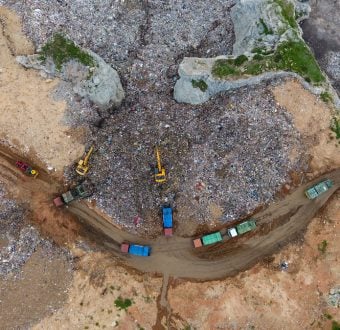If the world presented you with a rare and incredible opportunity to solidify a legacy as a true climate leader, you’d jump at it, right?

California Governor Jerry Brown speaks at a National Press Club media event. Groups from the ‘Brown’s Last Chance’ campaign rallied outside the National Press Building to demand that Governor Jerry Brown freeze new fossil fuel extraction in California and devise a plan to phase it out completely.
Now imagine being governor of a state where 39 million constituents — and 7.6 billion people around the world — have provided you the political capital to forge ahead with a clean energy future. Imagine now too, that you are the head of a state whose renewable energy sector (and thus, economy) is booming thanks to a mandate to generate half of the state’s electricity from renewable resources by 2030. Furthermore, you just so happen to be finishing up your last term in office, therefore insulated from the lobbying power of the fossil-fuel industry, and given the freedom to implement a roadmap for a sustainable future.
The decision to me seems obvious. And this is the exact position California’s Governor Jerry Brown finds himself in as he winds down his final months in office.
Listen, as a California resident and a mother, I fight to live in a place that puts communities over corporations and enacts policies that protect my family from the myriad of dangers that come from an industry all too willing to put profits over the environment. In many ways, I have seen California set ambitious climate goals by reducing its greenhouse gas emissions through stringent fuel emission standards while fighting back against the Trump Administration’s plans for offshore drilling. Governor Brown has shown dynamic climate leadership in these areas no doubt, and for that, I respect him.
Yet, despite soaring rhetoric, and to be fair, many actionable measures that address climate change, Governor Brown remains doggedly unwilling to rein in fossil-fuel exploration and development within California — and this is a huge problem. Even if we never added a single new oil or gas field, and simply totaled up the ones already in existence, they would still contain enough carbon to push us well past the 1.5C temperature increase we must maintain to avoid the worst impacts of climate change. To put it frankly, this is an unacceptable risk we can no longer afford.
Make no mistake, the effect this industry has on our state is profound. California is still reeling from the wildfires and mudslides that have crippled numerous regions and harmed so many in its path. Halfway through last year, the state had already racked up nearly 700 million dollars battling wildfires that burned over 500,000 acres, more than double the year before. As climate change increases the variability in temperature and precipitation, it’s creating the wild contrast we see between drought and floods, leaving us more at risk than ever before. Governor Brown has a remarkable opportunity to be the type of leader who will protect California citizens from future natural disasters by halting the single biggest factor in this crisis: our alarming dependence on fossil fuels. The last thing we need is another politician bowing to an industry that has been rapidly pushing us to the edge of the environmental cliff.

Thousands of homes and businesses have been destroyed in Northern California due to rampant wildfires, including whole neighborhoods reduced to smoldering rubble. 2017 saw one of the most devastating spate of wildfires to strike the state in modern history.
And let’s not forget— fossil fuels are not only catastrophic in their last phase of use but acutely destructive and dangerous for those in the wake of its extraction. Ask yourself if you would want your child to be forced to play in the shadow of a petrochemical plant built next to your home, or an oil field, or along local rivers polluted by oil spills and toxic waste — because this is the hazardous reality for many people.
This is particularly alarming for low-income communities and communities of color, who are historically more likely to be in the path of fracking rigs, oil pipelines, refineries and related infrastructure. Not only is this an environmental issue but a grave threat to public health. We can no longer accept that our communities face such risks for the sake of a dying industry. We need a government who also believes that everyone — not simply a select few — deserves the same fundamental rights afforded those with daily access to clean air, water, and a place to live.

Being forced to raise your children in the shadow of a petrochemical plant or an oil field is a frightening reality that no family should be forced to live with.
Over two years ago, world leaders convened in Paris to tackle the global crisis of climate change. How far have we really evolved since then? Honestly, not far enough. Governor Brown could be the one to draw a new map for California, for the U.S., and — by extension, the world — sending a strong message that America is serious in pursuing a just transition away from fossil fuels towards a cleaner, greener future.
At the end of the day, the inescapable truth is that citizen-led efforts are vastly important, but they alone will not be enough to stem the tide of climate change. We need an energy policy in California that will sharply reduce the use of fossil fuels by no longer granting new permits for exploration and allowing oil and gas infrastructure development. We are at a critical juncture in the fight for our planet, and the time is now for Brown to do the right thing — California demands it, our children need it, and our long-term survival depends on it.



